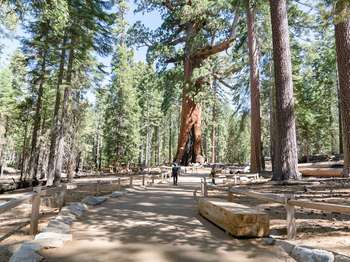Last updated: October 20, 2023
Place
Grizzly Giant Tour - Enduring Giant

Historical/Interpretive Information/Exhibits
Enduring Giant
The Grizzly Giant is one of the largest trees in the Mariposa Grove and is estimated to be 2,900 years old. As you near its base, look at the fires scars that remain. Fire plays a very important role in the growth of a giant sequoia.
Giant sequoias have a dependency on natural fires for reproduction, which was not understood until the early 1960s. Lightning-caused fires reduce the competition from other evergreens, burn away the leaf litter on the forest floor, and leave a thin layer of nutrient-rich ash over the mineral soil, creating perfect conditions for seedlings to sprout. Look at the forest floor around you. Can you see the soil? Or, do you see leaf litter covering the soil?
Also, the heat from a fire dries some of the mature trees' green sequoia cones, causing a shower of fresh seeds to fall onto a perfectly-prepared seedbed. When winter comes, snow blankets the Mariposa Grove. As the snowpack melts the following spring, sunlight, moisture, fresh seeds, ash, and mineral soil combine to create a sequoia nursery.
To reduce the leaf litter and promote giant sequoia reproduction, the National Park Service began igniting "prescribed burns," that are deliberately set and closely monitored by rangers, during spring and fall. When the forest returns to a more natural state, these management fires will most likely be discontinued. Then nature can resume its cycle of lightning-caused fires every five to twenty years. Read this wayside exhibit to learn more.
